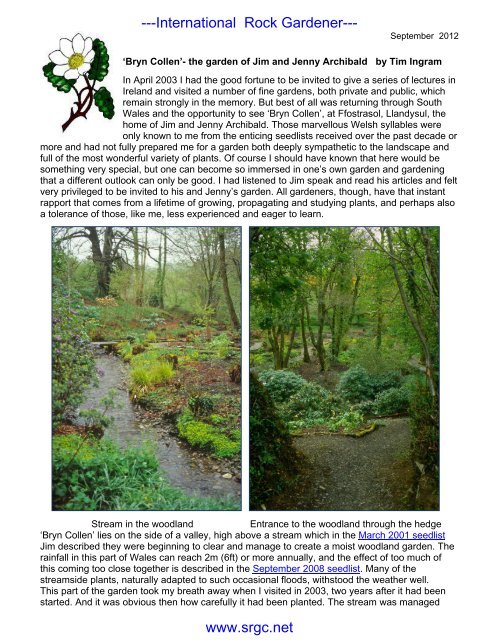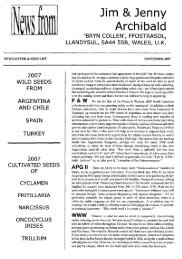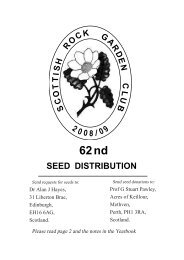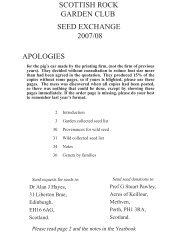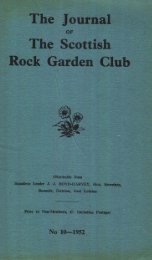You also want an ePaper? Increase the reach of your titles
YUMPU automatically turns print PDFs into web optimized ePapers that Google loves.
---International Rock Gardener---<br />
www.srgc.net<br />
September 2012<br />
‘<strong>Bryn</strong> <strong>Collen</strong>’- the garden of Jim and Jenny Archibald by Tim Ingram<br />
In April 2003 I had the good fortune to be invited to give a series of lectures in<br />
Ireland and visited a number of fine gardens, both private and public, which<br />
remain strongly in the memory. But best of all was returning through South<br />
Wales and the opportunity to see ‘<strong>Bryn</strong> <strong>Collen</strong>’, at Ffostrasol, Llandysul, the<br />
home of Jim and Jenny Archibald. Those marvellous Welsh syllables were<br />
only known to me from the enticing seedlists received over the past decade or<br />
more and had not fully prepared me for a garden both deeply sympathetic to the landscape and<br />
full of the most wonderful variety of plants. Of course I should have known that here would be<br />
something very special, but one can become so immersed in one’s own garden and gardening<br />
that a different outlook can only be good. I had listened to Jim speak and read his articles and felt<br />
very privileged to be invited to his and Jenny’s garden. All gardeners, though, have that instant<br />
rapport that comes from a lifetime of growing, propagating and studying plants, and perhaps also<br />
a tolerance of those, like me, less experienced and eager to learn.<br />
Stream in the woodland Entrance to the woodland through the hedge<br />
‘<strong>Bryn</strong> <strong>Collen</strong>’ lies on the side of a valley, high above a stream which in the March 2001 seedlist<br />
Jim described they were beginning to clear and manage to create a moist woodland garden. The<br />
rainfall in this part of Wales can reach 2m (6ft) or more annually, and the effect of too much of<br />
this coming too close together is described in the September 2008 seedlist. Many of the<br />
streamside plants, naturally adapted to such occasional floods, withstood the weather well.<br />
This part of the garden took my breath away when I visited in 2003, two years after it had been<br />
started. And it was obvious then how carefully it had been planted. The stream was managed
---International Rock Gardener---<br />
and divided to moderate and spread its flow and many choice species planted on the banks and<br />
at strategic points throughout the woodland. Coming through the narrow entrance in the hedge<br />
from the open garden above was both a surprise and a revelation. All really good gardens rely on<br />
contrast, both between plants and in the overall plantings, and I imagine that the woodland must<br />
have been the greatest fun to make; an opportunity to grow a whole range of plants impossible<br />
elsewhere. A few larger trees made focal points and winding stony paths enticing access to the<br />
streamlets and planting areas.<br />
Chrysoplenium davidianum and Caltha palustris carpeting the banks of the stream, with some<br />
good Meconopsis rosettes in the central “island”<br />
www.srgc.net
---International Rock Gardener---<br />
In places the fresh green foliage and sulphur-yellow flowerheads of Chrysoplenium davidianum<br />
completely carpeted the banks, and bold clumps of Lysichiton and Gunnera erupted from the<br />
moist soil. Low, near the constantly running water, were choice primulas, ‘King Cups’ (Caltha<br />
palustris) and the contrasting form of sedges.<br />
Lysichiton and Gunnera<br />
Higher in the woodsy soil between the trees, familiar woodland species such as trilliums,<br />
pulmonarias and ferns, interspersed with many rhododendrons ranging from dramatic large<br />
leaved species to the lovely glaucous, waxy-flowered cinnabarinum. Come summer with the<br />
leaves on the trees and perennials in full growth, the scene must have resembled a lush<br />
monsoon forest in the Himalayas! Much more time would have been needed to take in the full<br />
richness of the planting but already the garden captured the imagination and was a true work of<br />
art.<br />
Chaerophyllum hirsutum ‘Roseum’ Rheum palmatum ‘Atropurpureum’<br />
www.srgc.net
---International Rock Gardener---<br />
But of course the garden didn’t stop here! Above the woodland a small orchard of mature fruit<br />
trees was underplanted with hellebores and other woodland species, plus strong growing<br />
perennials like Euphorbia griffithii, which revels in damp soil, and the lovely pink umbel<br />
Chaerophyllum hirsutum ‘Roseum’. Rheum palmatum ‘Atropurpureum’ was magnificent in<br />
its expanding spring foliage, but not just one - planted in some numbers! A second smaller<br />
Rheum species made a fascinating conversation piece. Higher still and the garden became more<br />
open and loosely planted with smaller species of rhododendrons and other Ericaceae, choice<br />
shrubs like Fothergilla, and many bulbs and tidy early flowering perennials. The quality of the<br />
planting throughout could easily compare, and often outshine, any of the finest Botanic Gardens<br />
throughout the country, and reinforces the view that Jim was a plantsman and educator of the<br />
highest calibre. His often acerbic comments made in the introductions to the seedlists may have<br />
made uncomfortable reading at times but were strongly founded in experience, and their value no<br />
doubt recognised by many not in a position to posit them themselves.<br />
Above: Planting in the upper garden<br />
Right: Stock plants in a greenhouse<br />
Below: Helleborus vesicarius<br />
For me the highlight was the range of greenhouses and<br />
tunnels at the highest point of the garden, containing<br />
stock plants for seed and propagation which wouldn’t<br />
prosper in the open. Here was a treasure trove of rare<br />
species; bulbs of all kinds; probably the finest collection<br />
of peony species in the country; and oddball plants like<br />
the summer dry adapted Helleborus vesicarius.<br />
Most of the bulbs were grown traditionally and<br />
meticulously in pots. Many earlier flowering species of<br />
fritillarias and narcissi were over, but notable plants in<br />
full flower included burgeoning potfuls of all three forms<br />
of Tecophilaea cyanocrocus, the glorious and vivid<br />
flowering Anemone biflora, several Calochortus species<br />
(a genus rarely seen in cultivation, even given the<br />
greater availability from Dutch bulb growers in recent<br />
years), and some mouth-watering irises.<br />
www.srgc.net
---International Rock Gardener---<br />
Below: Tecophilaea cyanocrocus forms<br />
In the large polytunnel larger<br />
herbaceous species were planted out directly and included the most magnificent clump of<br />
Paeonia cambessedesii that I have ever seen! Along one side a shallow raised bed was<br />
devoted to an enviable collection of peony species; 28 different accessions are listed in the<br />
September 2008 seedlist, and those who have grown peonies from seed (slow but usually quite<br />
reliable) will know that this was a remarkable and painstaking resource, and an example of the<br />
immense value of growing and collecting seed of such plants in cultivation. Extraordinary and<br />
completely new to me was the rare and darkest maroon Paeonia parnassica, a very local<br />
endemic from Greece, and a plant I shall always wish I had obtained seed of when listed.<br />
Above: Stock plant tunnel Below: Paeonia cambessedesii and P. parnassica<br />
www.srgc.net
---International Rock Gardener---<br />
In this tunnel was the endangered Californian Delphinium luteum, along with a number of elegant<br />
Pacific Coast irises; trailers of Tropaeolum polyphyllum; a beautiful white form of Thalictrum<br />
orientale growing en masse; and a wonderful clump of the original Helleborus ‘Ballard’s Black’,<br />
showing how well this responded to the warm and dry conditions under cover. The very lovely<br />
azure-blue relative of muscari, Bellevalia forniculata (a Turkish species of melt water meadows in<br />
Erzurum), especially appealed to me, though attempts to establish it in our garden have not<br />
succeeded to date. The tunnel and greenhouses contained a true cornucopia of plants!<br />
Below: Thalictrum orientale<br />
A garden of this quality in the public sphere would be lauded and cherished by gardeners. There<br />
is no doubt that Jim himself had this effect on those who knew him, whilst at the same time<br />
making, with his wife Jenny, a garden that was a private masterpiece. Dr. Tim Ingram<br />
www.srgc.net


